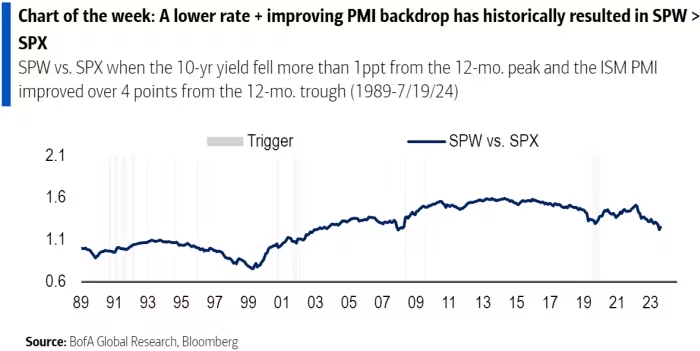BofA strategists highlight that historically, a lower Treasury yield and an improving manufacturing PMI have driven the outperformance of the equal-weighted S&P 500 index.
Recently, a surge in U.S. small-cap stocks has led investors to speculate whether this marks a shift away from this year’s Big Tech frontrunners.
According to BofA Global Research strategists, a lasting stock-market rotation depends on the 10-year Treasury yield remaining below 4% and the ISM manufacturing PMI index staying above 50%. Historically, the equal-weighted S&P 500 index has outperformed the market-cap-weighted S&P 500 90% of the time when the 10-year Treasury yield dropped by more than 1 percentage point from its 12-month peak, and the ISM manufacturing PMI improved by over 4 percentage points from its 12-month low, as noted by BofA strategists led by Ohsung Kwon.
For this rotation to continue, the 10-year yield needs to be around 3.99%, below its 52-week high of 4.99% recorded on October 19, and the ISM manufacturing PMI index should be above 50%, indicating expansion in the manufacturing sector.

“The manufacturing economy is experiencing its second-longest downturn in history, with 21 months without two consecutive months of PMI above 50%,” Kwon and his team wrote, attributing this mainly to the destocking cycle, which they expect to moderate in the second half of 2024.
The Institute for Supply Management’s manufacturing index fell to 48.5% in June from 48.7% in the previous month, with the lowest level in the past 12 months being 46.5% in July 2023. A PMI below 50% indicates contraction in the sector.
On Monday, the 10-year Treasury yield increased by 2.1 basis points to 4.259%, influenced by speculation that Vice President Kamala Harris might become the Democratic Party’s presidential nominee. This year, the 10-year rate has risen by nearly 40 basis points due to persistent inflation concerns, keeping the Federal Reserve cautious about cutting interest rates, according to FactSet data.
Despite this, traders in the federal-funds futures market on Monday saw a 93.6% probability that the Fed will start cutting its benchmark rate in September, based on the CME FedWatch Tool. However, policymakers will review upcoming inflation data before making a decision.
U.S. stocks closed higher on Monday, led by the “Magnificent Seven” and chip stocks like Nvidia, which rose by 4.76% after a challenging week.
The Nasdaq Composite increased by 1.6%, the S&P 500 by 1.1%, and the Dow Jones Industrial Average edged up by 0.3%, according to FactSet data.

Leave a Reply